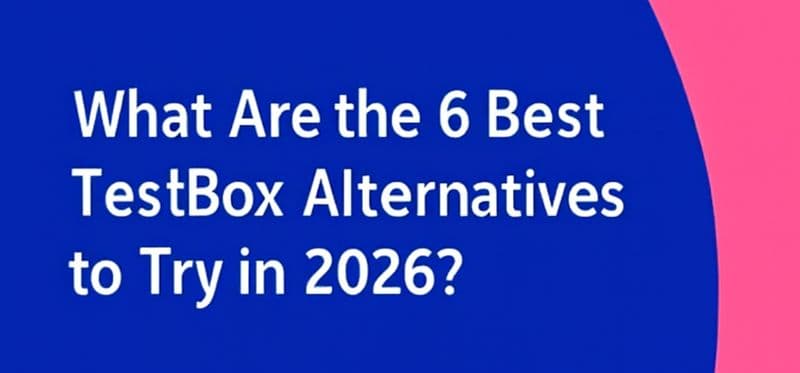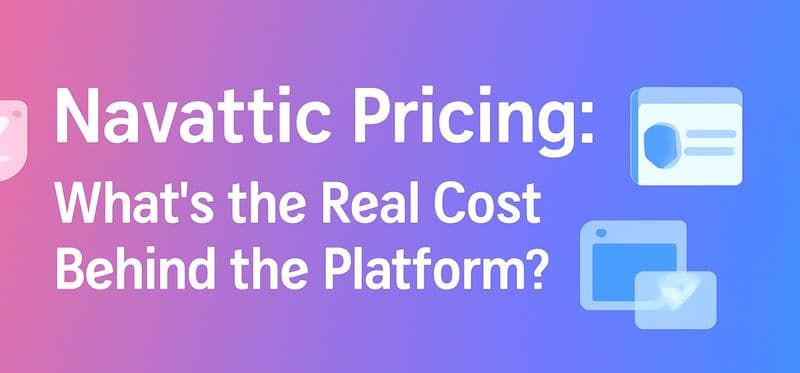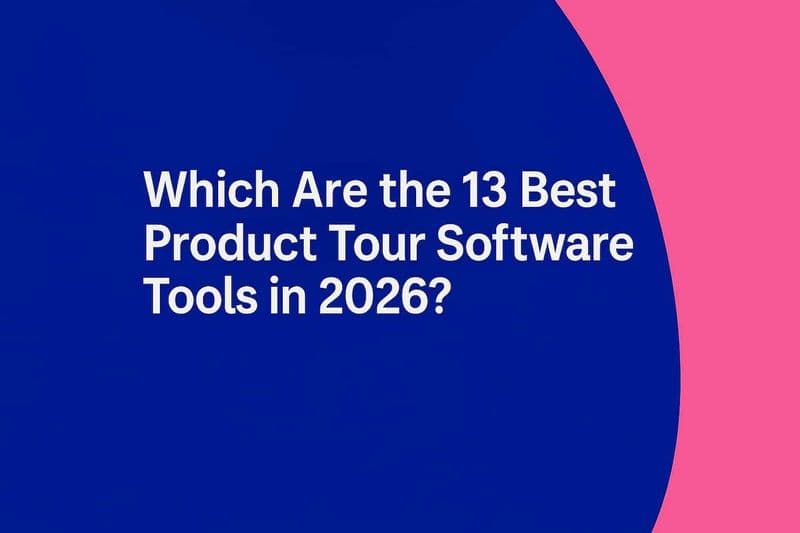
If you're a SaaS founder, few decisions are as high-stakes or as confusing as pricing. Set it too low, and you leave money on the table. Too high, and potential customers walk away. And with so many SaaS pricing models floating around, it's no wonder founders struggle to find the right fit.
But here’s the truth: your pricing strategy isn’t just about revenue—it's about positioning, customer segmentation, and long-term growth. The best SaaS pricing models align value with willingness to pay, reduce churn, and help you scale without burning through your Customer Acquisition Cost (CAC).
In this guide, we’ll discuss the best SaaS pricing models, provide real-world examples, and help you choose a structure that fits your product, market, and growth stage. Whether you're looking for B2B SaaS pricing models, planning to launch a new feature tier, or just need a SaaS pricing model template to test options, this is your starting point.
What Is a SaaS Pricing Model?
At its core, a SaaS pricing model is the method your company uses to charge customers for access to your software. It defines how much users pay, how often they pay, and often, what features or usage levels they get in return. From flat monthly fees to pay-as-you-go structures, these models shape your revenue, user experience, and long-term growth.
At its core, a SaaS pricing model should answer three key questions:
How do we structure our plans to reflect customer value?
How do we grow revenue with our existing base?
How do we keep CAC under control while increasing LTV?
Whether you're evaluating B2B SaaS pricing models, launching a new product, or benchmarking against competitors, understanding the logic behind pricing models for SaaS gives you a strategic edge.
Why Pricing Models Aren’t Enough—You Need Strategy
While pricing models define how you charge, your pricing strategy determines why you charge that way, and how it supports your growth. Think of the model as the structure, and the strategy as the engine driving your decisions.
You can copy a competitor’s pricing model, but without the right strategic foundation—customer insights, value metrics, positioning—you’ll miss the mark on growth, retention, and profitability. That’s why, before you finalize a price tag, you need to think bigger: what’s the business outcome you’re aiming for?
Let’s explore how to build a SaaS pricing strategy that aligns with your product vision and revenue goals.
Which SaaS Pricing Strategy Is Right for Your Startup?
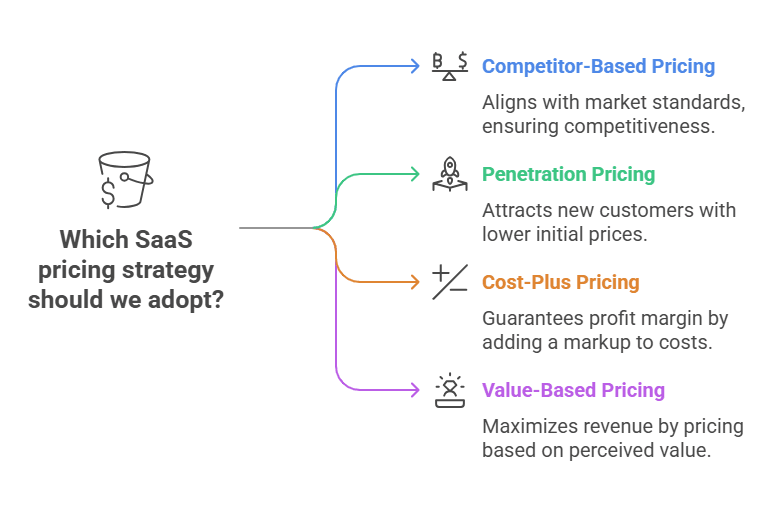
Not all SaaS pricing models are created equal. The right strategy can boost revenue, enhance positioning, and reduce churn, while the wrong one can kill growth. Whether you're testing early traction or scaling a mature product, knowing how to price your SaaS product is critical.
Let’s break down the different SaaS pricing models and when to use them.
1. Competitor-Based Pricing
Set your price in relation to what competitors are charging.
Best for: New entrants in a competitive market
Key considerations:
Price above competitors to signal premium value or advanced features.
Price below market to attract cost-conscious users and disrupt incumbents.
Watch out: Don’t blindly copy others. Your cost structure and value proposition may differ. Always anchor pricing decisions in your own positioning.
Example: ClickUp initially underpriced competitors like Asana and Trello while offering more robust features to grab market share fast.
This is one of the most common B2B SaaS pricing models, especially in crowded categories.
2. Penetration Pricing Strategy
Launch low to gain users fast, then increase prices over time.
Best for: New SaaS products aiming to build market share
Why it works:
Attracts early adopters quickly
Acts as a barrier against new competitors
Helps validate product-market fit fast
Risk: Short-term revenue loss. Your SaaS financial model template should include a breakeven analysis if you pursue this.
Example: Slack launched with a freemium model, allowing users to test the platform risk-free. It grew from 15k to 500k daily users in under a year.
This is popular in SaaS software pricing models that aim for freemium-to-paid conversion.
3. Cost-Plus Pricing
Calculate all costs and add a fixed margin.
Best for: Founders needing a simple starting point for pricing
Pros:
Easy to set up
Ensures margin on every sale
Useful when unit economics are still stabilising
Drawback: Ignores perceived customer value or competitor pricing. Customers don’t care how much it costs you—they care about the outcome they get.
Example: Early-stage infrastructure SaaS tools often start here—e.g., internal tools charging based on AWS costs + 20% markup.
Use this only as a baseline before layering in market dynamics and value-based inputs.
4. Value-Based Pricing
Price based on how much value your product delivers to the customer.
Best for: Mature products with clear ROI or customer differentiation
Advantages:
Maximises revenue per customer
Reflects customer willingness to pay
Often seen in the best SaaS pricing models
Requires effort:
You’ll need deep market research
Understanding personas and usage tiers is critical
Example: Salesforce charges different tiers based on business size and use case, aligning pricing to value delivered at each level.
This is often the most profitable of all pricing models for SaaS—but only if executed well.
Confused About SaaS Pricing? Here Are the Models That Actually Work
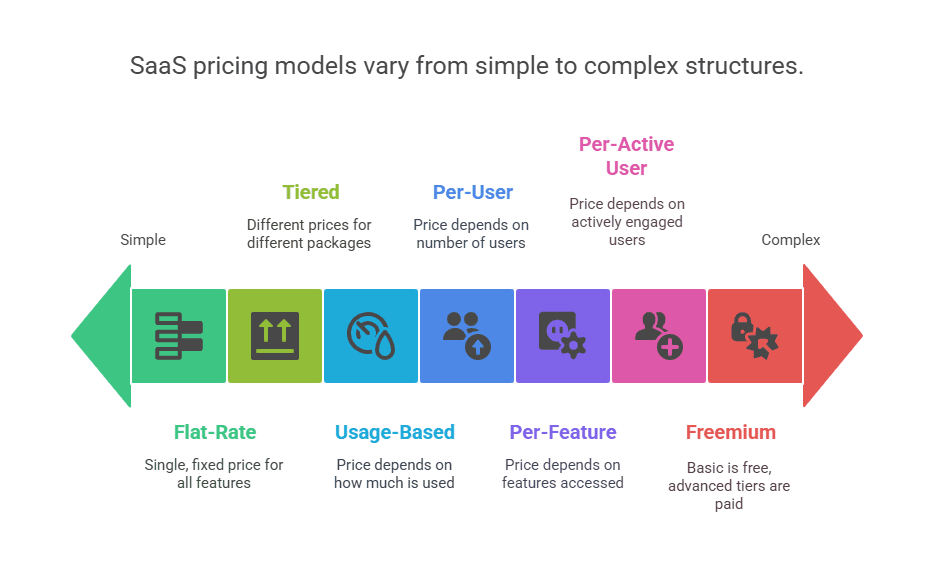
While SaaS pricing strategies define your approach, SaaS pricing models deal with the actual structure—how you charge users and what they get in return. Choosing the right model affects everything from user acquisition to customer lifetime value and churn.
Here’s a breakdown of the best SaaS pricing models, with real-world examples to help you figure out how to price your SaaS product effectively.
1. Flat-Rate Pricing Model
Charge one fixed price for one set of features.
Best for: Simple products with a single buyer persona
Pros | Cons |
|---|---|
Simple to explain and market | Doesn’t cater to different customer needs |
Predictable pricing for customers | Misses out on upsell potential from higher-value users |
Example: Basecamp charges a flat $99/month for unlimited users and features—great for small teams that want simplicity.
2. Tiered Pricing Model
Offer multiple packages at different price points based on features, usage, or users.
Best for: SaaS businesses targeting multiple customer segments
Pros | Cons |
|---|---|
Appeals to multiple personas | Can overwhelm customers with too many options |
Enables upselling as needs grow | Requires clear tier differentiation to avoid confusion |
Example: HubSpot offers distinct tiers for different business sizes, helping small startups and large enterprises find the right fit.
3. Usage-Based Pricing Model
Also known as "Pay-as-you-go." Customers pay based on how much they use.
Best for: Infrastructure-heavy B2B SaaS pricing models like APIs, data tools
Pros | Cons |
|---|---|
Fair pricing that scales with usage | Revenue forecasting becomes challenging |
Ideal for data-heavy or API tools | Focus on usage may dilute perceived product value |
4. Per User-Based Pricing Model
Price increases linearly with the number of users.
Best for: Team-based SaaS tools (CRM, project management)
Pros | Cons |
|---|---|
Easy to understand and scale | May discourage user expansion |
Predictable MRR for SaaS teams | Teams might share logins to avoid cost |
Example: Twilio charges per message or minute used, making it ideal for companies with fluctuating usage needs.
5. Per Feature Pricing Model
Charge more for access to premium features.
Best for: SaaS tools with wide-ranging functionality
Pros | Cons |
|---|---|
Aligns pricing with perceived value | Risk of overwhelming users with too many feature splits |
Encourages upgrades organically | Difficult to balance features across tiers |
Example: Slack charges per active user, enabling pricing that scales as teams grow.
6. Freemium Pricing Model
Offer a free version with limited features, and convert users to paid plans later.
Best for: Viral tools that rely on high user volume and word-of-mouth
Pros | Cons |
|---|---|
Strong for user acquisition | Can burn resources without revenue from free users |
Low barrier to entry for SMBs | May attract non-serious users, increasing churn |
Example: Zapier charges based on advanced automation features, app integrations, and task volumes.
7. Per Active User Pricing Model
Only charge for users who actively use the product.
Best for: Collaborative tools aiming for broad adoption
Pros | Cons |
|---|---|
Customers only pay for real usage | Revenue can vary month to month |
Reduces risk of overpaying | May not suit small businesses with inconsistent usage |
Example: Canva uses freemium to attract millions of users, then upgrades them to Pro with advanced design features and brand kits.
Pricing Strategy versus Pricing Model
It’s easy to confuse pricing strategy with pricing model, but they serve two different purposes in your go-to-market playbook. Your pricing strategy is the “why”—it guides your decision based on value, market positioning, and business goals. Your pricing model, on the other hand, is the “how”—the operational structure that determines how you charge customers.
Understanding both is key to building a pricing system that’s attractive to customers, scalable, predictable, and aligned with your product’s growth trajectory.
Here’s a clear side-by-side breakdown:
Aspect | Pricing Strategy | Pricing Model |
|---|---|---|
Definition | The philosophy or approach behind how you set your product's price | The tactical structure of how pricing is presented and billed to customers |
Focus Area | Strategic thinking around value, positioning, competition, and market entry | The actual billing structure—how users are charged (e.g., per user, per feature, usage-based) |
Goal | Maximise long-term revenue, market share, or user adoption based on business objectives | Make pricing easy to understand, implement, and scale with the customer |
Examples | Value-based pricing- Competitor-based pricing- Cost-plus pricing- Penetration pricing | Flat-rate pricing- Tiered pricing- Per-user pricing- Freemium- Usage-based pricing |
Customer Perception | How does the price feel in terms of fairness, value, and positioning compared to other options | How the customer is billed based on their usage or plan choice |
Influencing Factors | - Target market and buyer psychology- Competitive landscape- Brand positioning | - Product features- Usage metrics- User seats or team size |
Ties Into | - Go-to-market strategy- Sales and SaaS marketing positioning- LTV: CAC ratio | - Product packaging- Billing systems- Churn prevention |
Level of Customisation | Often abstract or high-level, flexible, depending on business growth goals | Highly defined and operational; implemented directly in the billing and pricing pages |
Key Metrics Influenced | - Average Revenue Per User (ARPU)- Customer Lifetime Value (LTV)- Market penetration | - Monthly Recurring Revenue (MRR)- Churn Rate- Expansion Revenue |
Common Misunderstanding | Mistaken as the pricing model itself | Seen as the strategic "why" behind pricing, when it’s the operational "how" |
SaaS Application | Helps determine whether to lead with a low price, premium value, or competitive matching | Determines if you’ll charge per user, per feature, or on a pay-as-you-go basis |
Relation to Each Other | Pricing strategy informs the choice of pricing model | Pricing model executes the strategy through your product and billing system |
How to Design the Best Pricing Model for Your SaaS Product?
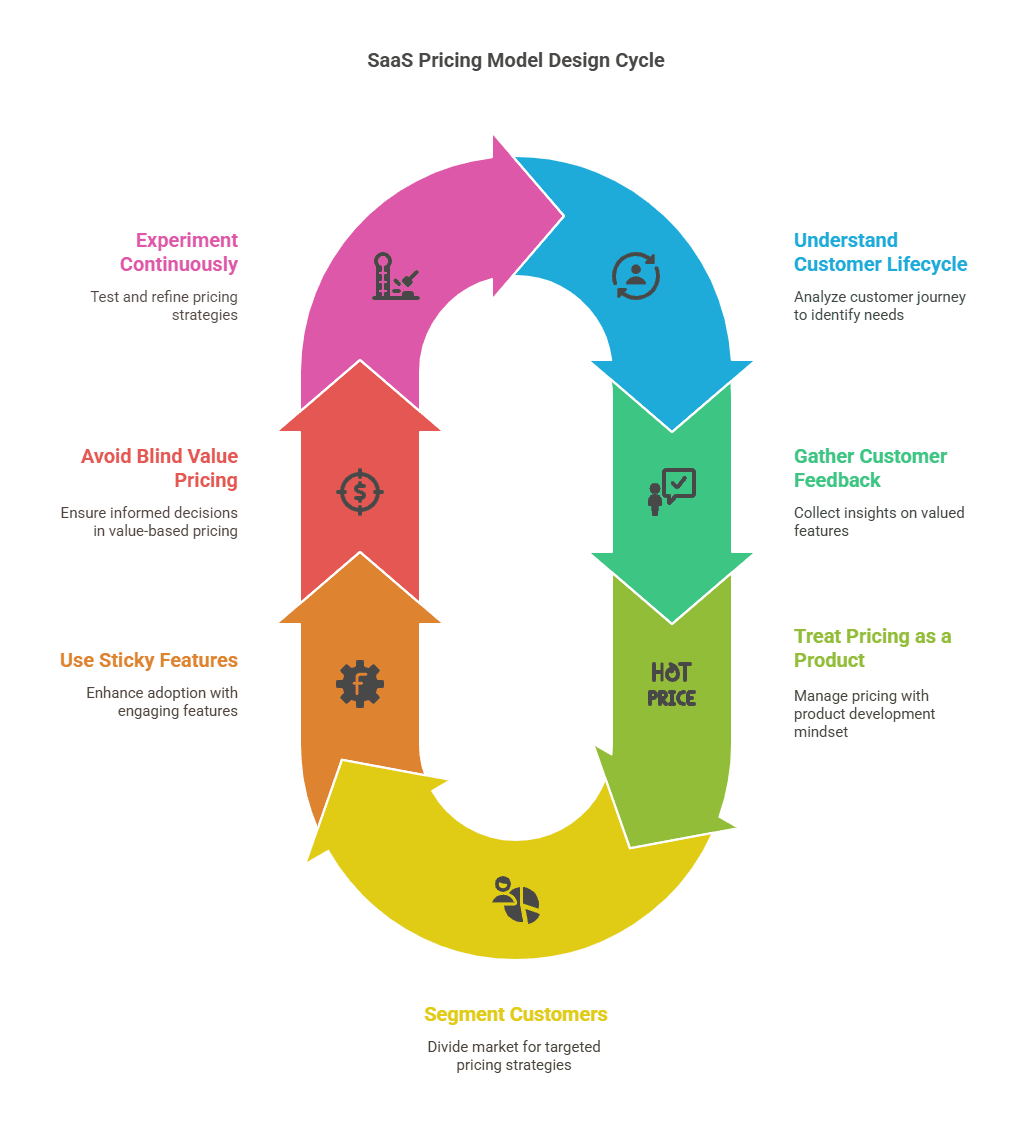
Designing the right pricing model is one of the most strategic decisions you'll make as a SaaS founder. It’s not just about revenue—your pricing influences adoption, retention, and customers' perception of your product. Whether you're testing early-stage models or refining your plans, here’s how to approach it clearly and confidently.
1. Start with the Full Customer Lifecycle
The best SaaS pricing models go beyond customer acquisition. Think about how pricing can support expansion and reduce churn across the user journey. Look for patterns in product usage and explore how pricing can incentivize upgrades, long-term commitments, or add-ons. Consider the role of pricing in driving higher CLTV, not just initial conversions.
2. Listen to What Your Customers Value
To truly understand how to price your SaaS product, start with your users. Customer feedback, usage analytics, and purchase history can reveal what features they’re willing to pay for—and which they don’t care about. Use this input to adjust your pricing structure, refine your tiers, or restructure your freemium offering.
3. Treat Pricing as a Product
Adopt a "Pricing-as-a-Product" mindset. That means building, testing, and iterating on pricing just like software. Use data to refine your pricing logic, run A/B tests on new models, and adapt based on segment performance. Keep your SaaS pricing model template updated as your product evolves and your customer base diversifies.
4. Segment Smartly
Different customer segments have different pricing sensitivities. Tailoring your pricing based on company size, use case, or region allows you to maximise revenue while remaining accessible. This is especially important for B2B SaaS pricing models, where enterprise buyers may expect more flexibility, value, and volume-based discounts.
5. Use Sticky Features to Drive Adoption
Offering limited access to “sticky” features that create daily habits or heavy reliance can be an effective tactic. It lowers the barrier to entry and provides a natural upsell path once users see the value. But track the data closely: not every free feature leads to conversions.
6. Don’t Jump into Value-Based Pricing Blindly
Value-based pricing is robust only when you have enough data to understand your customers' value. Early on, it’s better to start with simple SaaS software pricing models (like flat-rate or per-user), and slowly move toward value pricing as customer insights grow.
7. Keep Experimenting
Your pricing model isn’t set in stone. Markets shift, user expectations evolve, and your product matures. Regularly test different structures, messaging, and tier combinations. Over time, you’ll land on the best SaaS pricing models that balance growth, customer satisfaction, and profitability.
Don’t Just Price It Right—Pitch It Smarter with SmartCue
Choosing the right SaaS pricing model is crucial. But how you communicate that pricing, especially during demos, can be the difference between "just looking" and "where do I sign up?"
That’s where SmartCue comes in.
SmartCue helps SaaS companies like yours deliver personalized, no-code product walkthroughs tailored to the exact pricing tier, feature set, or use case your lead cares about. Whether you're trying to showcase the value of a higher tier, explain the ROI behind a freemium model upgrade, or walk enterprise buyers through your tiered pricing strategy, SmartCue equips your sales team with the tools to convert faster and reduce churn.
SmartCue isn’t just for selling—it’s for scaling. If you’ve spent time perfecting your pricing strategy, don’t let poor demo delivery leave revenue on the table.
Try SmartCue 14-Day Trial for Free Today and start converting curiosity into committed customers.
Conclusion
For SaaS companies, choosing the right pricing strategy isn’t just about setting a flat rate or offering a free plan—it’s about designing a pricing plan that aligns with your product's value, target market, and recurring revenue model. Whether you’re a lean SaaS startup experimenting with a freemium model or scaling into enterprise customers with a tiered pricing strategy, your pricing can shape everything from profit margin to customer support needs.
Frequently Asked Questions
How do I choose the best pricing strategy for my SaaS?
Choosing the best pricing strategy for your SaaS involves understanding your target customers' needs, how you provide value to them, analyzing your competitors' pricing, and considering your costs. It's advisable to start with simpler models and gradually transition into value-based pricing as you acquire more customer insights.
What are common pricing mistakes to avoid?
Common mistakes include ignoring customer needs and perceived value, setting prices based only on cost or competitors' pricing, sticking to a stagnant pricing model with no regular revisions or testing, and overcomplicating the pricing structure with too many variables and features, leading to customer confusion.
How often should pricing models be revisited?
Pricing models should be treated dynamically and revisited regularly, preferably every six months. This allows you to respond to changing market conditions, customer feedback, competitor pricing alterations, and new insights from your own pricing experiments.
What is the impact of pricing on customer retention?
Pricing has a direct impact on customer retention. A fair pricing model that aligns with the value customers derive from your product encourages loyalty and lengthens the customer lifecycle. Sudden or unfounded price hikes, on the other hand, may lead to increased churn.
Can pricing strategy affect overall brand perception?
Absolutely! Pricing strategy can greatly influence how your brand is perceived in the market. Premium pricing can position your brand as high-quality and exclusive. Conversely, low pricing might position it as affordable, but could also risk an association with low quality if not managed well.
